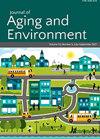Identifying Shelter and Housing Models for Older People Experiencing Homelessness
IF 1
Q3 GERONTOLOGY
引用次数: 5
Abstract
Abstract Limited research has identified the types of shelter/housing and supports for the growing population of older people experiencing homelessness (OPEH) and the extent to which existing models align with their needs. To redress this gap, we conducted an environmental scan and three World Café workshops to identify and characterize shelter/housing models for OPEH in Montreal, Calgary, and Vancouver (Canada). Fifty-two models were identified and categorized into six shelter/housing types based on the program length of stay and level of health and social supports provided onsite: (1) Emergency, transitional, or temporary shelter/housing with supports; (2) Independent housing with offsite community-based supports; (3) Supported independent housing with onsite, non-medical supports; (4) Permanent supportive housing with onsite medical support and/or specialized services; (5) Long-term care for individuals with complex health needs and; (6) Palliative care/hospice, offering end-of-life services. Models that met the unique needs of OPEH had coordinated supports, social and recreational programming, assistance with daily tasks, and had a person-centered, harm-reduction approach to care. This typology of shelter/housing models offers a basis from which local and regional governments can audit their existing shelter/housing options and determine where there may be gaps in supporting OPEH.为无家可归的老年人确定住房和住房模式
摘要有限的研究已经确定了为日益增多的无家可归老年人提供的住所/住房类型和支持,以及现有模式在多大程度上符合他们的需求。为了弥补这一差距,我们在蒙特利尔、卡尔加里和温哥华(加拿大)举办了一次环境扫描和三次世界咖啡馆研讨会,以确定和描述OPEH的住房/住房模式。根据项目停留时间以及现场提供的健康和社会支持水平,确定了52种模式,并将其分为六种避难所/住房类型:(1)紧急、过渡或临时避难所/住房;(2) 独立住房,提供异地社区支持;(3) 有现场非医疗支持的独立住房;(4) 提供现场医疗支持和/或专业服务的永久性支持性住房;(5) 为有复杂健康需求的个人提供长期护理;(6) 姑息治疗/临终关怀,提供临终服务。满足OPEH独特需求的模型具有协调的支持、社会和娱乐规划、日常任务援助,并具有以人为中心、减少伤害的护理方法。这种住房/住房模式的类型提供了一个基础,地方和地区政府可以据此审计其现有的住房/住房选择,并确定在支持OPEH方面可能存在的差距。
本文章由计算机程序翻译,如有差异,请以英文原文为准。
求助全文
约1分钟内获得全文
求助全文
来源期刊

Journal of Aging and Environment
Social Sciences-Sociology and Political Science
CiteScore
2.50
自引率
5.00%
发文量
21
 求助内容:
求助内容: 应助结果提醒方式:
应助结果提醒方式:


